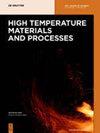Investigation of microstructure, machinability, and mechanical properties of new-generation hybrid lead-free brass alloys
IF 1.5
4区 材料科学
Q4 MATERIALS SCIENCE, MULTIDISCIPLINARY
引用次数: 0
Abstract
Abstract In this study, hybrid alloys were obtained by casting method with alloy elements and additive such as Si and MoS2, which can be used instead of lead, and compared with Ecobrass and free cutting brass samples used in the market in terms of microstructure, mechanical, and machinability properties. The microstructures of lead-free hybridized brass consists of alpha, beta, and intermetallic compound which were confirmed by the results of X-Ray Diffraction analysis and Scanning Electron Microscopy-Energy Dispersive Spectroscopy. The hardness values of the beta phase in the microstructure are between 180 and 220 Vickers hardness. It has been observed that increasing the amount of beta prime phase also increases the hardness. The machinability of samples was evaluated in terms of surface roughness and chip formation. Chips obtained from samples after machining process were categorized according to ISO 6385-G1 standard. Chip morphologies were examined under optic microscope and scanning electron microscope. The surface roughness value of samples with MoS2 additives was found to be the lowest due to its lubricity effect. Moreover, morphologies, distribution of phases, and intermetallic compounds in the microstructure are found to have a great impact on the machinability and ultimate tensile strength.新一代杂化无铅黄铜合金的显微组织、切削性能和力学性能研究
摘要:本研究采用浇铸法制备了可代替铅使用的合金元素和添加剂Si、MoS2等混合合金,并与市场上常用的Ecobrass和自由切削黄铜样品进行了显微组织、力学性能和可切削性能的比较。无铅杂化黄铜的显微结构由α、β和金属间化合物组成,经x射线衍射分析和扫描电镜-能谱分析证实。显微组织中β相的硬度值在180 ~ 220维氏之间。研究发现,增加初相的量也能提高硬度。根据表面粗糙度和切屑形成来评估样品的可加工性。根据ISO 6385-G1标准对加工后样品获得的切屑进行分类。在光学显微镜和扫描电镜下观察芯片的形貌。添加了二硫化钼的样品,由于其润滑作用,表面粗糙度值最低。此外,微观组织中的形貌、相分布和金属间化合物对可加工性和极限抗拉强度有很大影响。
本文章由计算机程序翻译,如有差异,请以英文原文为准。
求助全文
约1分钟内获得全文
求助全文
来源期刊

High Temperature Materials and Processes
工程技术-材料科学:综合
CiteScore
2.50
自引率
0.00%
发文量
42
审稿时长
3.9 months
期刊介绍:
High Temperature Materials and Processes offers an international publication forum for new ideas, insights and results related to high-temperature materials and processes in science and technology. The journal publishes original research papers and short communications addressing topics at the forefront of high-temperature materials research including processing of various materials at high temperatures. Occasionally, reviews of a specific topic are included. The journal also publishes special issues featuring ongoing research programs as well as symposia of high-temperature materials and processes, and other related research activities.
Emphasis is placed on the multi-disciplinary nature of high-temperature materials and processes for various materials in a variety of states. Such a nature of the journal will help readers who wish to become acquainted with related subjects by obtaining information of various aspects of high-temperature materials research. The increasing spread of information on these subjects will also help to shed light on relevant topics of high-temperature materials and processes outside of readers’ own core specialties.
 求助内容:
求助内容: 应助结果提醒方式:
应助结果提醒方式:


